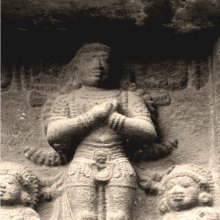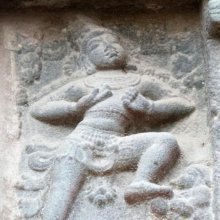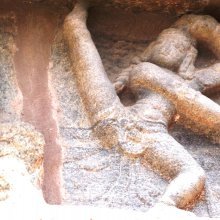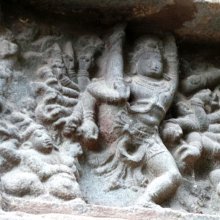Avita, Avīta, Avitā, Āvīta: 12 definitions
Introduction:
Avita means something in Hinduism, Sanskrit, Buddhism, Pali, Marathi, Tamil. If you want to know the exact meaning, history, etymology or English translation of this term then check out the descriptions on this page. Add your comment or reference to a book if you want to contribute to this summary article.
Images (photo gallery)
Languages of India and abroad
Pali-English dictionary
Source: BuddhaSasana: Concise Pali-English Dictionaryavīta : (adj.) not free from.

Pali is the language of the Tipiṭaka, which is the sacred canon of Theravāda Buddhism and contains much of the Buddha’s speech. Closeley related to Sanskrit, both languages are used interchangeably between religions.
Marathi-English dictionary
Source: DDSA: The Molesworth Marathi and English Dictionaryavīṭa (अवीट).—a (a & viṭaṇēṃ) Unfading--a color: never wearying or palling--an article of food: undecaying, unfailing;--used of the precious stones and metals: not to be nauseated or disgusted;--used of a man pertinaciously wicked: that does not readily wear, waste, yield, fail;--used of trinkets, vessels, the body, buildings &c.: immoderate, immodest, licentious--speech: exuberant--a crop. There are other and still more lax applications of this word: all, however, bearing the general sense Unfailing or enduring. 2 Unfailing; an epithet of God.
Source: DDSA: The Aryabhusan school dictionary, Marathi-Englishavīṭa (अवीट).—a Unfading–a colour; never wearying or palling–an article of food; undecaying, unfalling-used of metals &c.; that does not readily wear, waste–used of buildings, ves- sels &c.
Marathi is an Indo-European language having over 70 million native speakers people in (predominantly) Maharashtra India. Marathi, like many other Indo-Aryan languages, evolved from early forms of Prakrit, which itself is a subset of Sanskrit, one of the most ancient languages of the world.
Sanskrit dictionary
Source: DDSA: The practical Sanskrit-English dictionaryAvitā (अविता).—An ewe, a sheep.
--- OR ---
Avīta (अवीत).—A variety of अनुमान (anumāna) or inference; (vyatirekamukhena pravartamānaṃ niṣedhakamavītam; yathā pṛthivī pṛthivītarabhinnā gandhavattvāt Tv.).
Derivable forms: avītam (अवीतम्).
--- OR ---
Āvīta (आवीत).—a. [ā-vye-kta]
1) Worn, put on, held after throwing round.
2) Entered, passed, gone.
-tam The sacrificial cord worn in any particular position.
Source: Cologne Digital Sanskrit Dictionaries: Shabda-Sagara Sanskrit-English DictionaryAvita (अवित).—mfn.
(-taḥ-tā-taṃ) Preserved, protected. E. ava to preserve, kta affix of part. past.
--- OR ---
Āvīta (आवीत).—mfn.
(-taḥ-tā-taṃ) 1. Passed, gone. 2. Placed, hung. m.
(-taḥ) The sacrificial cord worn in any particular manner. E. āṅ before vīta gone.
Source: Cologne Digital Sanskrit Dictionaries: Cappeller Sanskrit-English DictionaryĀvīta (आवीत).—v. prācīnāvīta & prācīnāvītin.
Source: Cologne Digital Sanskrit Dictionaries: Monier-Williams Sanskrit-English Dictionary1) Avita (अवित):—[from avi] a avitṛ, avithya. See ss.vv.
2) b mfn. (√av). protected, [cf. Lexicographers, esp. such as amarasiṃha, halāyudha, hemacandra, etc.] (cf. adroghāvita.)
3) Avīta (अवीत):—[=a-vīta] mf(ā)n. (√vī), not enjoyed (as the sacrificial oblation), [Ṛg-veda iv, 48, 1]
4) Āvīta (आवीत):—[=ā-vīta] a and āvītin See ā-√vye.
5) [=ā-vīta] [from ā-vye] b mfn. covered, invested (especially with the sacred thread).
Source: Cologne Digital Sanskrit Dictionaries: Yates Sanskrit-English Dictionary1) Avita (अवित):—[a-vita] (taḥ-tā-taṃ) a. Preserved.
2) Āvīta (आवीत):—[ā-vīta] (taḥ-tā-taṃ) a. Gone; placed. m. Sacrificial cord worn by brāhmaṃs over the left shoulder.
Source: DDSA: Paia-sadda-mahannavo; a comprehensive Prakrit Hindi dictionary (S)Avita (अवित) in the Sanskrit language is related to the Prakrit word: Avia.
[Sanskrit to German]
Sanskrit, also spelled संस्कृतम् (saṃskṛtam), is an ancient language of India commonly seen as the grandmother of the Indo-European language family (even English!). Closely allied with Prakrit and Pali, Sanskrit is more exhaustive in both grammar and terms and has the most extensive collection of literature in the world, greatly surpassing its sister-languages Greek and Latin.
Tamil dictionary
Source: DDSA: University of Madras: Tamil LexiconAvitā (அவிதா) interjection < avidhā. Exclamation used in calling for help; ஆபத்தில் முறையிட்டுக் கூறும் சொல். ஆவ வெந்தாயென் றவிதாவிடு நம்மவர் [apathil muraiyittug kurum sol. ava venthayen ravithavidu nammavar] (திருவாசகம் [thiruvasagam] 5, 4).
Tamil is an ancient language of India from the Dravidian family spoken by roughly 250 million people mainly in southern India and Sri Lanka.
See also (Relevant definitions)
Starts with (+13): A-vitam, Avitaavadi, Avitadbhashana, Avitaha, Avitai, Avitaiyar, Avitaka, Avitakka, Avitakka Sutta, Avitakka-avicaradhipati, Avitan, Avitana, Avitanya, Avitar, Avitaraga, Avitarana, Avitarin, Avitarka, Avitarkita, Avitarkya.
Ends with (+143): Abhavita, Abhibhavita, Adhavita, Adroghavita, Advayaprabhavita, Akavita, Akhilabhavita, Antarbhavita, Anudhavita, Anupradhavita, Anuravita, Anussavita, Apabhavita, Aplavita, Aprastavita, Apravita, Aravita, Asambhavita, Ashruplavita, Atavita.
Full-text (+4): Avia, Avida, Avitin, Pracinavita, Avitri, Avide, Avidho, Civata, Bhagevita, Gandhesha, Avitaka, Parivi, Av, Vitaraga, Adrogha, Avidha, Avidham, Tana, Vira, Vye.
Relevant text
Search found 11 books and stories containing Avita, Avīta, Avīṭa, Avitā, Āvīta, A-vita, A-vīta, Ā-vīta, Avitha, Avithaa, Avida, Avidha; (plurals include: Avitas, Avītas, Avīṭas, Avitās, Āvītas, vitas, vītas, Avithas, Avithaas, Avidas, Avidhas). You can also click to the full overview containing English textual excerpts. Below are direct links for the most relevant articles:
Anumana in Indian Philosophy (by Sangita Chakravarty)
(B). Divisions of Anumāna (in Sāṃkhya-Yoga Philosophy) < [Chapter 3 - Treatment of Anumāna in Sāṃkhya-Yoga Philosophy]
(A). Definition of Anumāna (in Sāṃkhya-Yoga Philosophy) < [Chapter 3 - Treatment of Anumāna in Sāṃkhya-Yoga Philosophy]
The Mahavastu (great story) (by J. J. Jones)
Chapter XXX - The story of Mālinī < [Volume I]
Chapter XIX - The Jātaka of Gaṅgapāla < [Volume III]
Chapter IX(a) - The Five Hundred Merchants (prose) < [Volume III]
Rig Veda (translation and commentary) (by H. H. Wilson)
Contribution of Vachaspati-Mishra to Samkhya System (by Sasikumar. B)
Chapter 3.4 - Epistemology and Ontology (conclusion)
Chapter 3.2 - Epistemology of Sāṅkhya System
Brihad Bhagavatamrita (commentary) (by Śrī Śrīmad Bhaktivedānta Nārāyana Gosvāmī Mahārāja)
Verse 2.1.28 < [Chapter 1 - Vairāgya (renunciation)]
Reverberations of Dharmakirti’s Philosophy (by Birgit Kellner)
Related products




